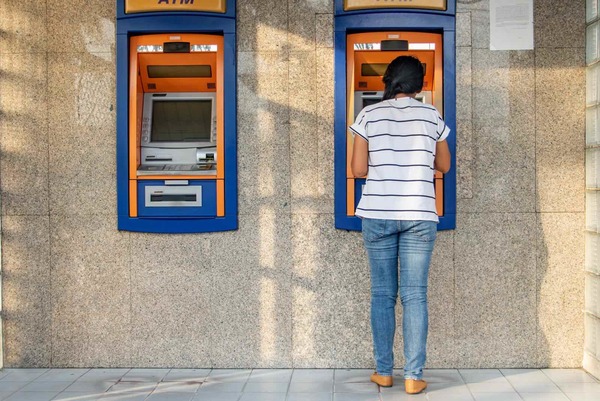You can better understand why your money is not growing by learning how a savings account works.
If you have a standard savings account, you most likely have specific financial goals. Yet, it often takes a lot longer than most think to meet those goals. Why savings accounts earn so little interest has a lot to do with the fact that banks are making less money on loans.
The connection between savings accounts and loans lies with the Federal Reserve. The Feds keep interest rates low to benefit those needing to borrow money, like new home buyers. The downside of lower rates is its impact on savers.
According to the Federal Deposit Insurance Corporation (FDIC), the national average interest rate on savings accounts is 0.05 percent. This anemic rate applies to both average and large deposits – even accounts with balances over $100,000. Thus, if you have $5,000 in savings, the annual interest you gain is $2.50. It is easy to see how a savings account can earn so little, but why?
Gain a better understanding of why your money is not growing by learning how a savings account works.
How Savings Account Works
For everyday deposits and withdrawals of cash, most use a checking account. Unless you have a high-yield checking account, you likely won't earn any interest on your balance. A savings account is different for many reasons, but most notably, it can bear interest.
Who Determines Interest Rates?
In the United States, the Federal Open Market Committee (FOMC) determines interest rates. The committee includes seven governors of the Federal Reserve Board and five Federal Reserve Bank presidents. The current interest rate is a low 0.05 percent. With the effects COVID-19 has had on the economy, it is not expected that the Federal Reserve will raise rates any time soon.
This expectation is glorious news for borrowers, and it shows: according to Freddie Mac, mortgage rates are at historic lows. In August, mortgage rates for 30-year and 15-year fixed-rate home loans were below 3 percent. Low rates continue to benefit borrowers but not savers.
When the Feds decrease interest rates, most banks lower their rates too. Yet this does not guarantee that the number will be the same everywhere. It varies among financial institutions. What stays the same is the impact that low rates have on regular savings accounts.
Some banks require a minimum balance to have a savings account, but this is not always the case. Many try to offer an interest rate that will help your savings grow, even if only by a few cents. Make sure you check the interest rates at your financial institution before enrolling.
Reasons Your Savings Is Not Growing
Your money is not growing for several reasons. The most significant one stems from banks having to ensure profitability.
Low-Interest Rates Vs. High-Interest Rates
When bank rates decrease, borrowing money becomes less expensive for customers. It makes getting a loan or making large purchases using a credit card more affordable. Banks typically keep rates of savings accounts lower than loan rates. This way, banks can continue making money on them. Drops to the interest rates are causing your savings to grow at snail-paced speeds.
When rates increase, borrowing money becomes more expensive. The rise in rates restrains many bank customers from performing financial activities. i.e., credit card purchases, mortgage loans, etc.
The upside of having higher interest rates is how they benefit savers. When interest rates rise, savings accounts often receive better interest rates.
Why Have a Savings Account?
For some, dealing with inconsistent interest rates is not worth opening a savings account – especially when most will only gain a few dollars in interest per year. Instead, some prefer to keep their extra dollars under their mattress, metaphorically speaking. Although fluctuating interest rates can be a hassle, some may argue differently. With a savings account, you know growth is happening even if it is at a slow pace. You are also aware that an increase will eventually appear in time. But the same cannot be said about a shoebox, which is why so many people have a savings account.
And it is not the only reason.
Federally insured banks also insure their customers' money. These banks use the Federal Deposit Insurance Corporation (FDIC).
Formed by the U.S. Congress, the FDIC is an independent agency. Its purpose is to preserve stability and public trust in the nation's financial system. Thus, if an FDIC-insured bank goes out of business, you will not lose all your savings. The FDIC insures your money up to $250,000, which is something else a shoebox cannot do.
Savings Account: Primary Money Goal
If you are unsure whether a savings account is the best place for your money, consider what your primary goal is for the money. A savings account is a great way to keep the money you wish to keep safe and accessible. If you're more interested in growing the money, a high yield checking account might be a better fit.
If you're set on having a savings account but want the best possible interest rate, consider opening an account with an online bank. Even though they also have felt the effects of the pandemic, online banks can be more competitive when it comes to interest rates.
Best Online Banks Offering High-Interest Rates
According to Bankrate, these online banks offer the best savings accounts with high-interest rates:
- Ally's savings account offers an interest rate of 0.60 percent.
- Capital One offers 0.65 percent on its 360 Performance Savings account.
- Citibank’s savings account rate is 0.90 percent.
- Discover Bank's interest rate for a savings account is 0.70 percent.
Conclusion
As the annual percentage yield for federally insured savings accounts is a mere 0.05 percent, switching banks might sound like a good idea.
If you plan on taking your money to another bank, ask yourself these three essential things:
- "Is the money in your savings account insured?"
- "What is your primary money goal?"
- "Will a switch in banks negatively impact your current savings?"
If you do not know the answers, do some research, and compare financial institutions.
Keep in mind that banks with high-interest rates are not immune to economic or federal changes, including pandemics.
You can say goodbye to using a savings account that earns so little interest. If you want to grow your savings at a faster speed, know your risks, rewards, and options.







